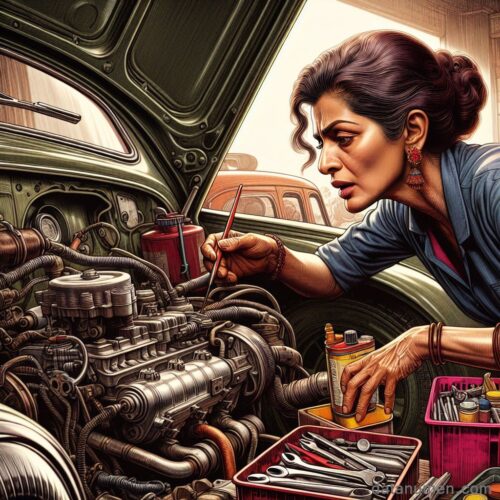1. Assessing the Situation
Upon encountering a broken car with no oil, the man begins to carefully assess the extent of the damage. He inspects the engine, checking for any visible signs of oil leakage or any other potential issues that could have caused the breakdown. The man takes note of any strange noises or unusual odors coming from the vehicle.
After a thorough examination, the man realizes that the car is indeed low on oil and this could be the root cause of the problem. He considers the potential consequences of driving the car in this condition and decides that it would be best to address the issue immediately before further damage is done to the engine.
The man quickly formulates a plan of action, determining that adding oil to the car’s engine is necessary to get it back up and running. He gathers the necessary tools and equipment to complete the task efficiently, taking into account the type and amount of oil required for the specific make and model of the vehicle.
With a sense of purpose and determination, the man sets out to rectify the situation, understanding the importance of proper maintenance and care for his car to ensure its longevity and performance on the road. Through his swift and decisive actions, the man demonstrates his ability to assess and address challenging situations effectively.

2. Searching for Alternatives
When faced with the dilemma of needing to replace the oil in his car, the man embarks on a quest to find alternative substances that can perform the same function. He knows that using the wrong type of oil can have detrimental effects on the engine, so he is determined to explore all possible options.
His first step is to research different types of oils that are suitable for his car’s engine. He reads about conventional oils, synthetic oils, and even high-mileage oils to understand their properties and benefits. However, he realizes that purchasing these oils can be expensive, especially if he needs to do frequent oil changes.
Feeling resourceful, the man decides to look into natural alternatives that may be readily available and more cost-effective. He discovers that some car enthusiasts swear by using coconut oil or vegetable oil as a substitute for conventional motor oil. Intrigued by this idea, he experiments with these options to see how well they perform in his car.
Throughout his search, the man remains cautious and ensures that he only considers substances that are safe for his engine. He understands the importance of proper lubrication to prevent engine damage and prolong the life of his vehicle. Despite the challenges he faces in finding the right alternative, he is determined to explore all possibilities until he finds a suitable replacement for the oil in his car.

3. Repairing the Car
After carefully considering his options, he settles on a particular substance to utilize in the repair process. With a clear plan in mind, he proceeds to implement the chosen alternative oil replacement to restore the functionality of the car. The repair work begins as he addresses the specific issue that has been hindering the vehicle’s performance.

4. Testing the Car
After completing the repair, the man tests the car to ensure it is functioning properly.
Testing the car after a repair is a crucial step to ensure that all issues have been addressed and that the vehicle is safe to drive. The man carefully goes through a series of tests to check different components of the car.
Checking Mechanical Components
The first step in testing the car is to check the mechanical components. The man inspects the engine, brakes, transmission, and other vital parts to make sure they are working properly. He listens for any unusual sounds and checks for leaks or other signs of wear and tear.
Test Drive
After inspecting the mechanical components, the man takes the car for a test drive. He drives on different types of roads, including highways and local streets, to test the steering, suspension, and overall performance of the vehicle. During the test drive, he pays close attention to any vibrations, noises, or handling issues.
Diagnostic Tools
In addition to visual inspections and test drives, the man also uses diagnostic tools to check for any hidden issues. He connects a scanner to the car’s onboard computer to read error codes and monitor various parameters. This helps him identify any electronic or sensor-related problems that may not be obvious during a visual inspection.
Overall, testing the car is a critical step in the repair process. By thoroughly checking all components and systems, the man ensures that the car is safe and reliable for the customer to drive.

Leave a Reply